Prevalence and Determinants of Depression among International Students
VerifiedAdded on 2023/03/31
|17
|4020
|202
AI Summary
This research study aims to investigate the prevalence and determinants of depression among international students studying in Western Sydney University. It will analyze the impact of various factors such as language barriers, cultural differences, and academic stress on the mental health of international students. The study will use online surveys and psychological assessment scales to collect data and provide insights into the mental health issues faced by international students.
Contribute Materials
Your contribution can guide someone’s learning journey. Share your
documents today.
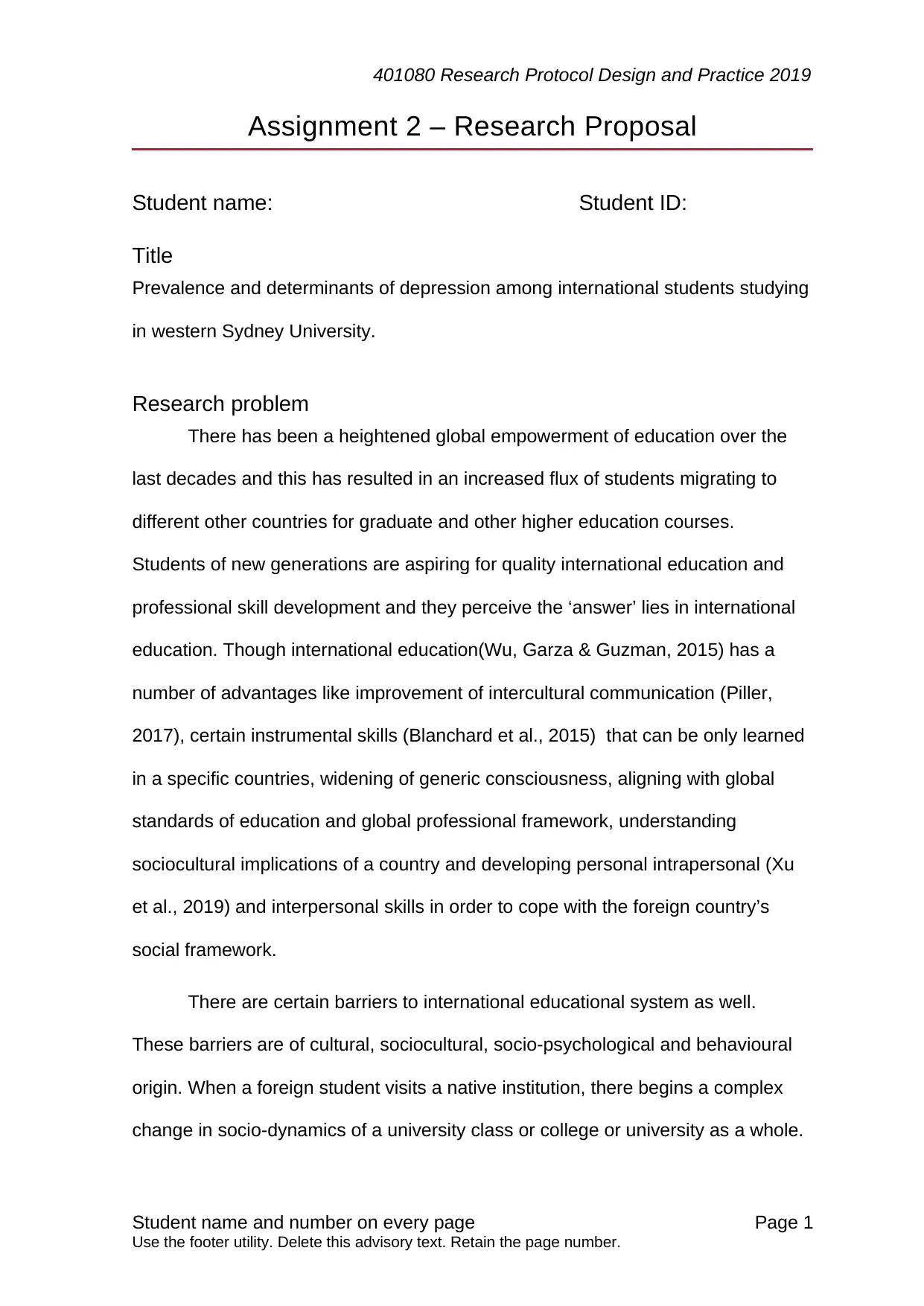
401080 Research Protocol Design and Practice 2019
Assignment 2 – Research Proposal
Student name: Student ID:
Title
Prevalence and determinants of depression among international students studying
in western Sydney University.
Research problem
There has been a heightened global empowerment of education over the
last decades and this has resulted in an increased flux of students migrating to
different other countries for graduate and other higher education courses.
Students of new generations are aspiring for quality international education and
professional skill development and they perceive the ‘answer’ lies in international
education. Though international education(Wu, Garza & Guzman, 2015) has a
number of advantages like improvement of intercultural communication (Piller,
2017), certain instrumental skills (Blanchard et al., 2015) that can be only learned
in a specific countries, widening of generic consciousness, aligning with global
standards of education and global professional framework, understanding
sociocultural implications of a country and developing personal intrapersonal (Xu
et al., 2019) and interpersonal skills in order to cope with the foreign country’s
social framework.
There are certain barriers to international educational system as well.
These barriers are of cultural, sociocultural, socio-psychological and behavioural
origin. When a foreign student visits a native institution, there begins a complex
change in socio-dynamics of a university class or college or university as a whole.
Student name and number on every page Page 1
Use the footer utility. Delete this advisory text. Retain the page number.
Assignment 2 – Research Proposal
Student name: Student ID:
Title
Prevalence and determinants of depression among international students studying
in western Sydney University.
Research problem
There has been a heightened global empowerment of education over the
last decades and this has resulted in an increased flux of students migrating to
different other countries for graduate and other higher education courses.
Students of new generations are aspiring for quality international education and
professional skill development and they perceive the ‘answer’ lies in international
education. Though international education(Wu, Garza & Guzman, 2015) has a
number of advantages like improvement of intercultural communication (Piller,
2017), certain instrumental skills (Blanchard et al., 2015) that can be only learned
in a specific countries, widening of generic consciousness, aligning with global
standards of education and global professional framework, understanding
sociocultural implications of a country and developing personal intrapersonal (Xu
et al., 2019) and interpersonal skills in order to cope with the foreign country’s
social framework.
There are certain barriers to international educational system as well.
These barriers are of cultural, sociocultural, socio-psychological and behavioural
origin. When a foreign student visits a native institution, there begins a complex
change in socio-dynamics of a university class or college or university as a whole.
Student name and number on every page Page 1
Use the footer utility. Delete this advisory text. Retain the page number.
Secure Best Marks with AI Grader
Need help grading? Try our AI Grader for instant feedback on your assignments.
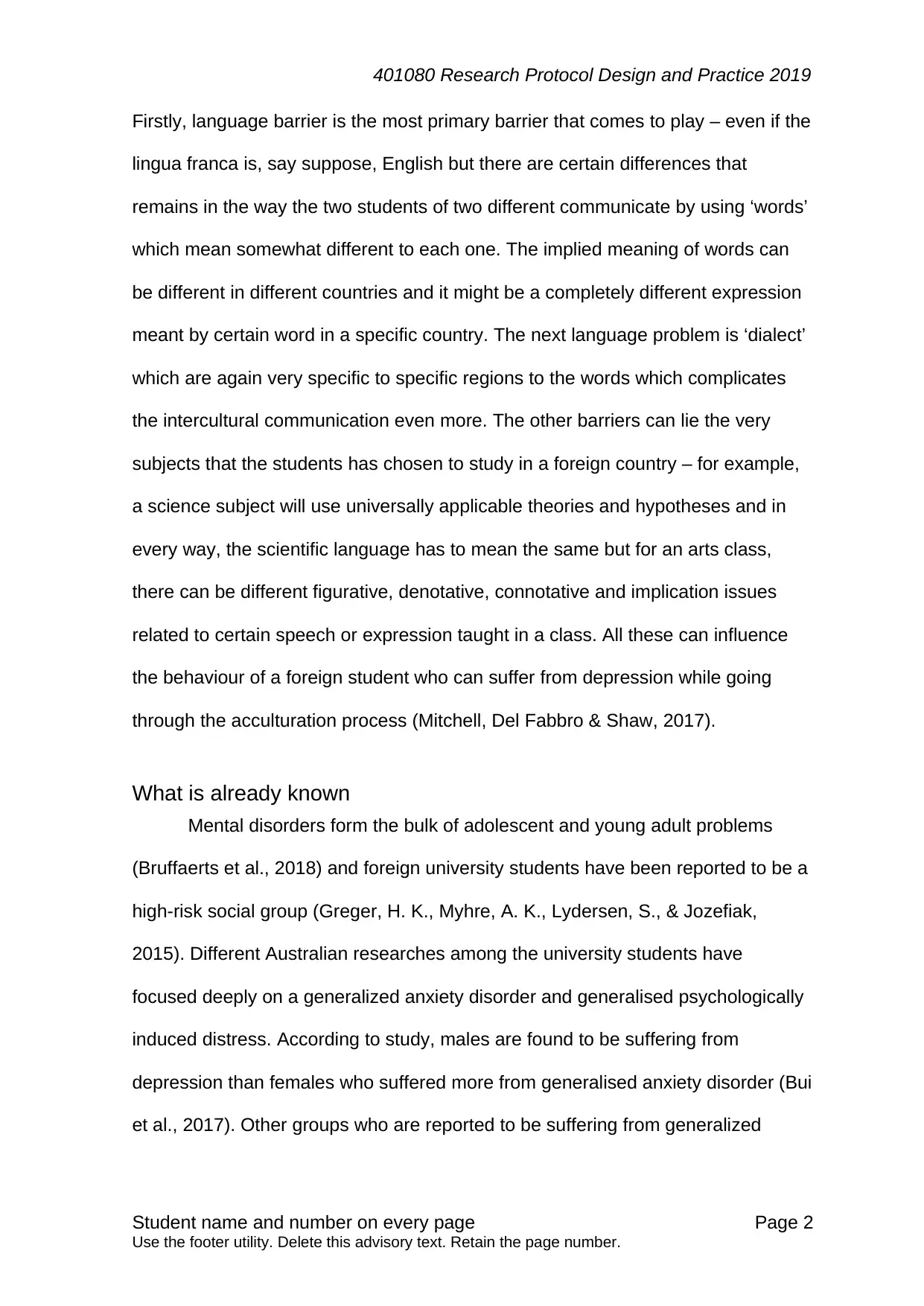
401080 Research Protocol Design and Practice 2019
Firstly, language barrier is the most primary barrier that comes to play – even if the
lingua franca is, say suppose, English but there are certain differences that
remains in the way the two students of two different communicate by using ‘words’
which mean somewhat different to each one. The implied meaning of words can
be different in different countries and it might be a completely different expression
meant by certain word in a specific country. The next language problem is ‘dialect’
which are again very specific to specific regions to the words which complicates
the intercultural communication even more. The other barriers can lie the very
subjects that the students has chosen to study in a foreign country – for example,
a science subject will use universally applicable theories and hypotheses and in
every way, the scientific language has to mean the same but for an arts class,
there can be different figurative, denotative, connotative and implication issues
related to certain speech or expression taught in a class. All these can influence
the behaviour of a foreign student who can suffer from depression while going
through the acculturation process (Mitchell, Del Fabbro & Shaw, 2017).
What is already known
Mental disorders form the bulk of adolescent and young adult problems
(Bruffaerts et al., 2018) and foreign university students have been reported to be a
high-risk social group (Greger, H. K., Myhre, A. K., Lydersen, S., & Jozefiak,
2015). Different Australian researches among the university students have
focused deeply on a generalized anxiety disorder and generalised psychologically
induced distress. According to study, males are found to be suffering from
depression than females who suffered more from generalised anxiety disorder (Bui
et al., 2017). Other groups who are reported to be suffering from generalized
Student name and number on every page Page 2
Use the footer utility. Delete this advisory text. Retain the page number.
Firstly, language barrier is the most primary barrier that comes to play – even if the
lingua franca is, say suppose, English but there are certain differences that
remains in the way the two students of two different communicate by using ‘words’
which mean somewhat different to each one. The implied meaning of words can
be different in different countries and it might be a completely different expression
meant by certain word in a specific country. The next language problem is ‘dialect’
which are again very specific to specific regions to the words which complicates
the intercultural communication even more. The other barriers can lie the very
subjects that the students has chosen to study in a foreign country – for example,
a science subject will use universally applicable theories and hypotheses and in
every way, the scientific language has to mean the same but for an arts class,
there can be different figurative, denotative, connotative and implication issues
related to certain speech or expression taught in a class. All these can influence
the behaviour of a foreign student who can suffer from depression while going
through the acculturation process (Mitchell, Del Fabbro & Shaw, 2017).
What is already known
Mental disorders form the bulk of adolescent and young adult problems
(Bruffaerts et al., 2018) and foreign university students have been reported to be a
high-risk social group (Greger, H. K., Myhre, A. K., Lydersen, S., & Jozefiak,
2015). Different Australian researches among the university students have
focused deeply on a generalized anxiety disorder and generalised psychologically
induced distress. According to study, males are found to be suffering from
depression than females who suffered more from generalised anxiety disorder (Bui
et al., 2017). Other groups who are reported to be suffering from generalized
Student name and number on every page Page 2
Use the footer utility. Delete this advisory text. Retain the page number.
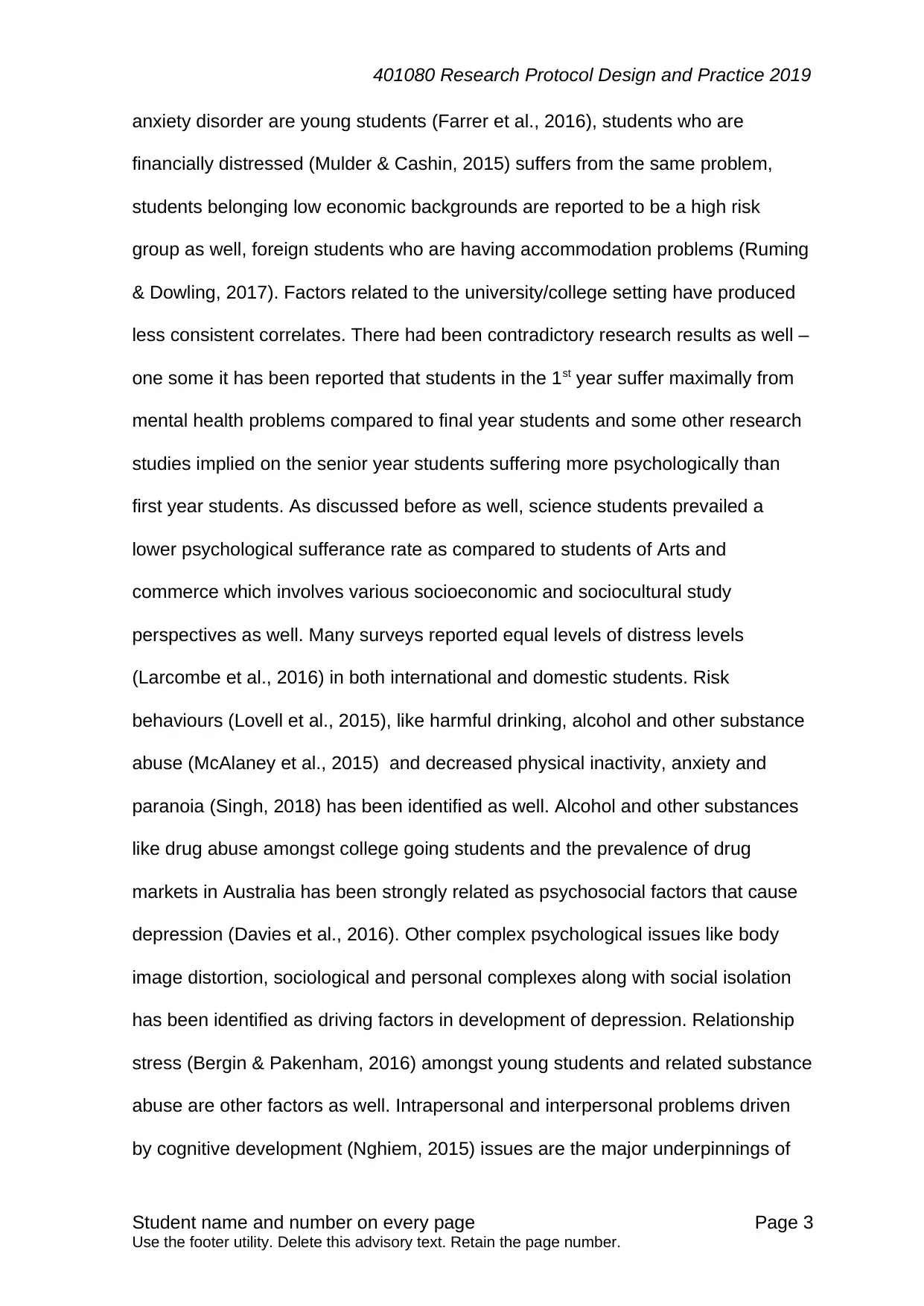
401080 Research Protocol Design and Practice 2019
anxiety disorder are young students (Farrer et al., 2016), students who are
financially distressed (Mulder & Cashin, 2015) suffers from the same problem,
students belonging low economic backgrounds are reported to be a high risk
group as well, foreign students who are having accommodation problems (Ruming
& Dowling, 2017). Factors related to the university/college setting have produced
less consistent correlates. There had been contradictory research results as well –
one some it has been reported that students in the 1st year suffer maximally from
mental health problems compared to final year students and some other research
studies implied on the senior year students suffering more psychologically than
first year students. As discussed before as well, science students prevailed a
lower psychological sufferance rate as compared to students of Arts and
commerce which involves various socioeconomic and sociocultural study
perspectives as well. Many surveys reported equal levels of distress levels
(Larcombe et al., 2016) in both international and domestic students. Risk
behaviours (Lovell et al., 2015), like harmful drinking, alcohol and other substance
abuse (McAlaney et al., 2015) and decreased physical inactivity, anxiety and
paranoia (Singh, 2018) has been identified as well. Alcohol and other substances
like drug abuse amongst college going students and the prevalence of drug
markets in Australia has been strongly related as psychosocial factors that cause
depression (Davies et al., 2016). Other complex psychological issues like body
image distortion, sociological and personal complexes along with social isolation
has been identified as driving factors in development of depression. Relationship
stress (Bergin & Pakenham, 2016) amongst young students and related substance
abuse are other factors as well. Intrapersonal and interpersonal problems driven
by cognitive development (Nghiem, 2015) issues are the major underpinnings of
Student name and number on every page Page 3
Use the footer utility. Delete this advisory text. Retain the page number.
anxiety disorder are young students (Farrer et al., 2016), students who are
financially distressed (Mulder & Cashin, 2015) suffers from the same problem,
students belonging low economic backgrounds are reported to be a high risk
group as well, foreign students who are having accommodation problems (Ruming
& Dowling, 2017). Factors related to the university/college setting have produced
less consistent correlates. There had been contradictory research results as well –
one some it has been reported that students in the 1st year suffer maximally from
mental health problems compared to final year students and some other research
studies implied on the senior year students suffering more psychologically than
first year students. As discussed before as well, science students prevailed a
lower psychological sufferance rate as compared to students of Arts and
commerce which involves various socioeconomic and sociocultural study
perspectives as well. Many surveys reported equal levels of distress levels
(Larcombe et al., 2016) in both international and domestic students. Risk
behaviours (Lovell et al., 2015), like harmful drinking, alcohol and other substance
abuse (McAlaney et al., 2015) and decreased physical inactivity, anxiety and
paranoia (Singh, 2018) has been identified as well. Alcohol and other substances
like drug abuse amongst college going students and the prevalence of drug
markets in Australia has been strongly related as psychosocial factors that cause
depression (Davies et al., 2016). Other complex psychological issues like body
image distortion, sociological and personal complexes along with social isolation
has been identified as driving factors in development of depression. Relationship
stress (Bergin & Pakenham, 2016) amongst young students and related substance
abuse are other factors as well. Intrapersonal and interpersonal problems driven
by cognitive development (Nghiem, 2015) issues are the major underpinnings of
Student name and number on every page Page 3
Use the footer utility. Delete this advisory text. Retain the page number.
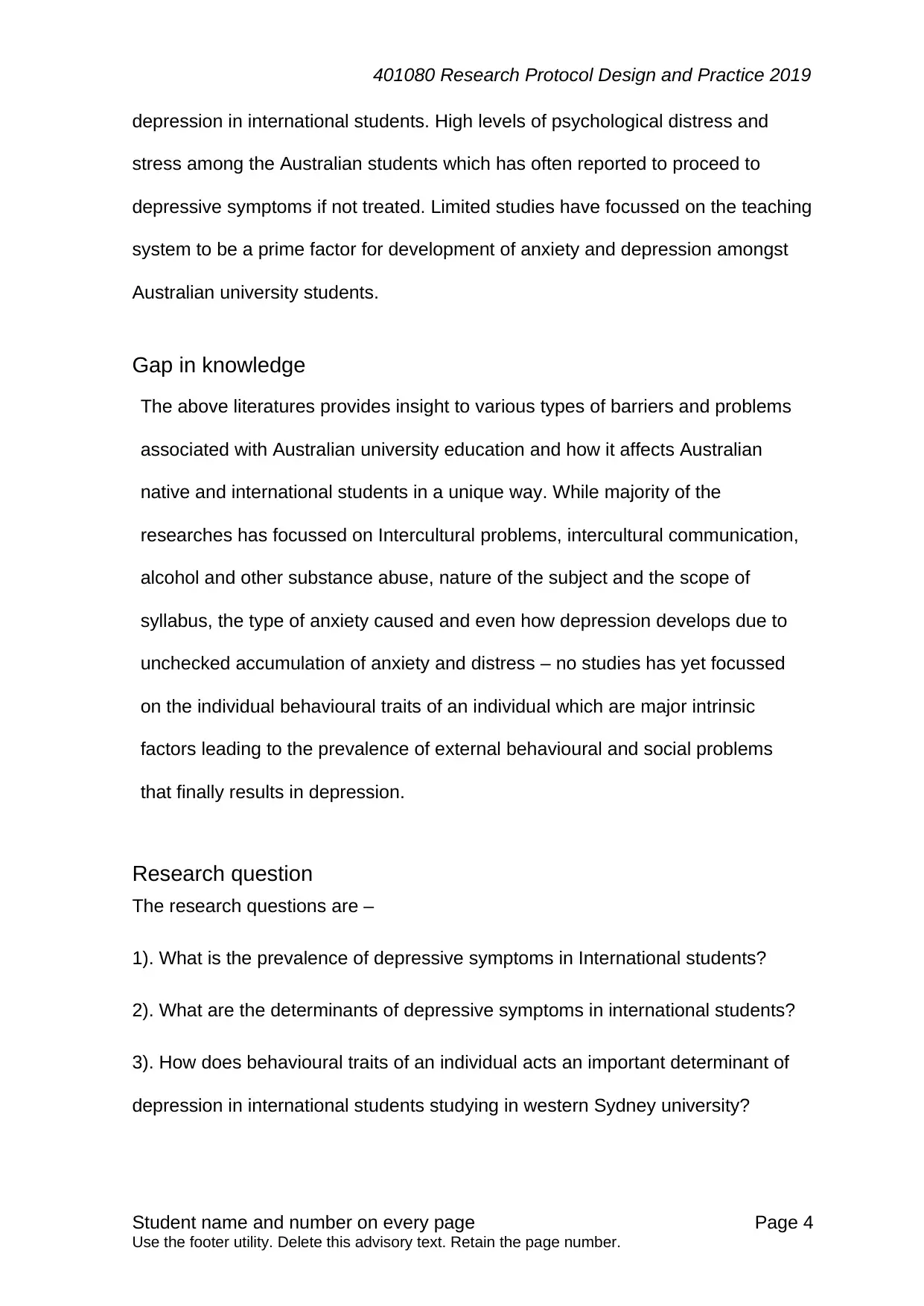
401080 Research Protocol Design and Practice 2019
depression in international students. High levels of psychological distress and
stress among the Australian students which has often reported to proceed to
depressive symptoms if not treated. Limited studies have focussed on the teaching
system to be a prime factor for development of anxiety and depression amongst
Australian university students.
Gap in knowledge
The above literatures provides insight to various types of barriers and problems
associated with Australian university education and how it affects Australian
native and international students in a unique way. While majority of the
researches has focussed on Intercultural problems, intercultural communication,
alcohol and other substance abuse, nature of the subject and the scope of
syllabus, the type of anxiety caused and even how depression develops due to
unchecked accumulation of anxiety and distress – no studies has yet focussed
on the individual behavioural traits of an individual which are major intrinsic
factors leading to the prevalence of external behavioural and social problems
that finally results in depression.
Research question
The research questions are –
1). What is the prevalence of depressive symptoms in International students?
2). What are the determinants of depressive symptoms in international students?
3). How does behavioural traits of an individual acts an important determinant of
depression in international students studying in western Sydney university?
Student name and number on every page Page 4
Use the footer utility. Delete this advisory text. Retain the page number.
depression in international students. High levels of psychological distress and
stress among the Australian students which has often reported to proceed to
depressive symptoms if not treated. Limited studies have focussed on the teaching
system to be a prime factor for development of anxiety and depression amongst
Australian university students.
Gap in knowledge
The above literatures provides insight to various types of barriers and problems
associated with Australian university education and how it affects Australian
native and international students in a unique way. While majority of the
researches has focussed on Intercultural problems, intercultural communication,
alcohol and other substance abuse, nature of the subject and the scope of
syllabus, the type of anxiety caused and even how depression develops due to
unchecked accumulation of anxiety and distress – no studies has yet focussed
on the individual behavioural traits of an individual which are major intrinsic
factors leading to the prevalence of external behavioural and social problems
that finally results in depression.
Research question
The research questions are –
1). What is the prevalence of depressive symptoms in International students?
2). What are the determinants of depressive symptoms in international students?
3). How does behavioural traits of an individual acts an important determinant of
depression in international students studying in western Sydney university?
Student name and number on every page Page 4
Use the footer utility. Delete this advisory text. Retain the page number.
Secure Best Marks with AI Grader
Need help grading? Try our AI Grader for instant feedback on your assignments.
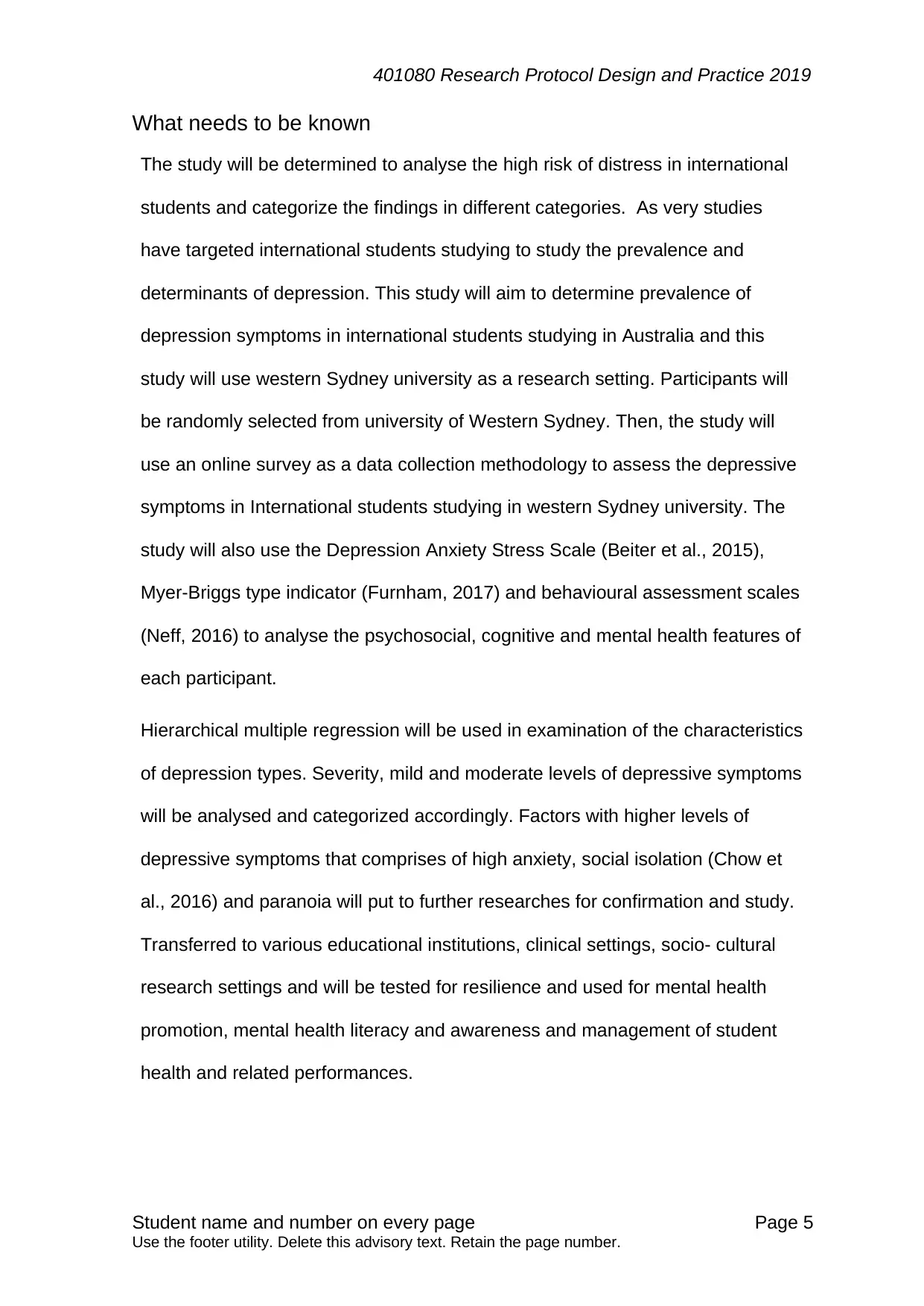
401080 Research Protocol Design and Practice 2019
What needs to be known
The study will be determined to analyse the high risk of distress in international
students and categorize the findings in different categories. As very studies
have targeted international students studying to study the prevalence and
determinants of depression. This study will aim to determine prevalence of
depression symptoms in international students studying in Australia and this
study will use western Sydney university as a research setting. Participants will
be randomly selected from university of Western Sydney. Then, the study will
use an online survey as a data collection methodology to assess the depressive
symptoms in International students studying in western Sydney university. The
study will also use the Depression Anxiety Stress Scale (Beiter et al., 2015),
Myer-Briggs type indicator (Furnham, 2017) and behavioural assessment scales
(Neff, 2016) to analyse the psychosocial, cognitive and mental health features of
each participant.
Hierarchical multiple regression will be used in examination of the characteristics
of depression types. Severity, mild and moderate levels of depressive symptoms
will be analysed and categorized accordingly. Factors with higher levels of
depressive symptoms that comprises of high anxiety, social isolation (Chow et
al., 2016) and paranoia will put to further researches for confirmation and study.
Transferred to various educational institutions, clinical settings, socio- cultural
research settings and will be tested for resilience and used for mental health
promotion, mental health literacy and awareness and management of student
health and related performances.
Student name and number on every page Page 5
Use the footer utility. Delete this advisory text. Retain the page number.
What needs to be known
The study will be determined to analyse the high risk of distress in international
students and categorize the findings in different categories. As very studies
have targeted international students studying to study the prevalence and
determinants of depression. This study will aim to determine prevalence of
depression symptoms in international students studying in Australia and this
study will use western Sydney university as a research setting. Participants will
be randomly selected from university of Western Sydney. Then, the study will
use an online survey as a data collection methodology to assess the depressive
symptoms in International students studying in western Sydney university. The
study will also use the Depression Anxiety Stress Scale (Beiter et al., 2015),
Myer-Briggs type indicator (Furnham, 2017) and behavioural assessment scales
(Neff, 2016) to analyse the psychosocial, cognitive and mental health features of
each participant.
Hierarchical multiple regression will be used in examination of the characteristics
of depression types. Severity, mild and moderate levels of depressive symptoms
will be analysed and categorized accordingly. Factors with higher levels of
depressive symptoms that comprises of high anxiety, social isolation (Chow et
al., 2016) and paranoia will put to further researches for confirmation and study.
Transferred to various educational institutions, clinical settings, socio- cultural
research settings and will be tested for resilience and used for mental health
promotion, mental health literacy and awareness and management of student
health and related performances.
Student name and number on every page Page 5
Use the footer utility. Delete this advisory text. Retain the page number.
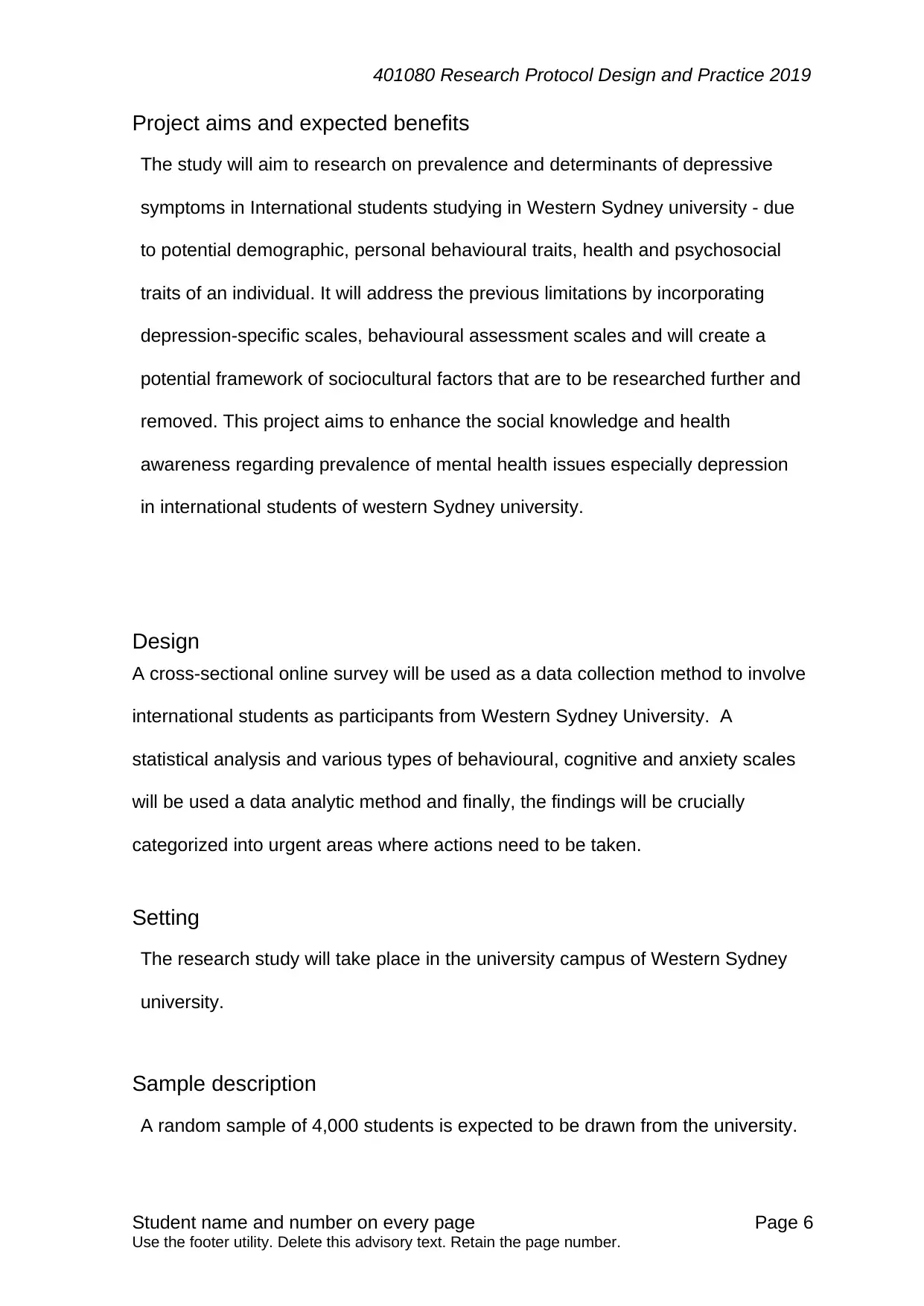
401080 Research Protocol Design and Practice 2019
Project aims and expected benefits
The study will aim to research on prevalence and determinants of depressive
symptoms in International students studying in Western Sydney university - due
to potential demographic, personal behavioural traits, health and psychosocial
traits of an individual. It will address the previous limitations by incorporating
depression-specific scales, behavioural assessment scales and will create a
potential framework of sociocultural factors that are to be researched further and
removed. This project aims to enhance the social knowledge and health
awareness regarding prevalence of mental health issues especially depression
in international students of western Sydney university.
Design
A cross-sectional online survey will be used as a data collection method to involve
international students as participants from Western Sydney University. A
statistical analysis and various types of behavioural, cognitive and anxiety scales
will be used a data analytic method and finally, the findings will be crucially
categorized into urgent areas where actions need to be taken.
Setting
The research study will take place in the university campus of Western Sydney
university.
Sample description
A random sample of 4,000 students is expected to be drawn from the university.
Student name and number on every page Page 6
Use the footer utility. Delete this advisory text. Retain the page number.
Project aims and expected benefits
The study will aim to research on prevalence and determinants of depressive
symptoms in International students studying in Western Sydney university - due
to potential demographic, personal behavioural traits, health and psychosocial
traits of an individual. It will address the previous limitations by incorporating
depression-specific scales, behavioural assessment scales and will create a
potential framework of sociocultural factors that are to be researched further and
removed. This project aims to enhance the social knowledge and health
awareness regarding prevalence of mental health issues especially depression
in international students of western Sydney university.
Design
A cross-sectional online survey will be used as a data collection method to involve
international students as participants from Western Sydney University. A
statistical analysis and various types of behavioural, cognitive and anxiety scales
will be used a data analytic method and finally, the findings will be crucially
categorized into urgent areas where actions need to be taken.
Setting
The research study will take place in the university campus of Western Sydney
university.
Sample description
A random sample of 4,000 students is expected to be drawn from the university.
Student name and number on every page Page 6
Use the footer utility. Delete this advisory text. Retain the page number.
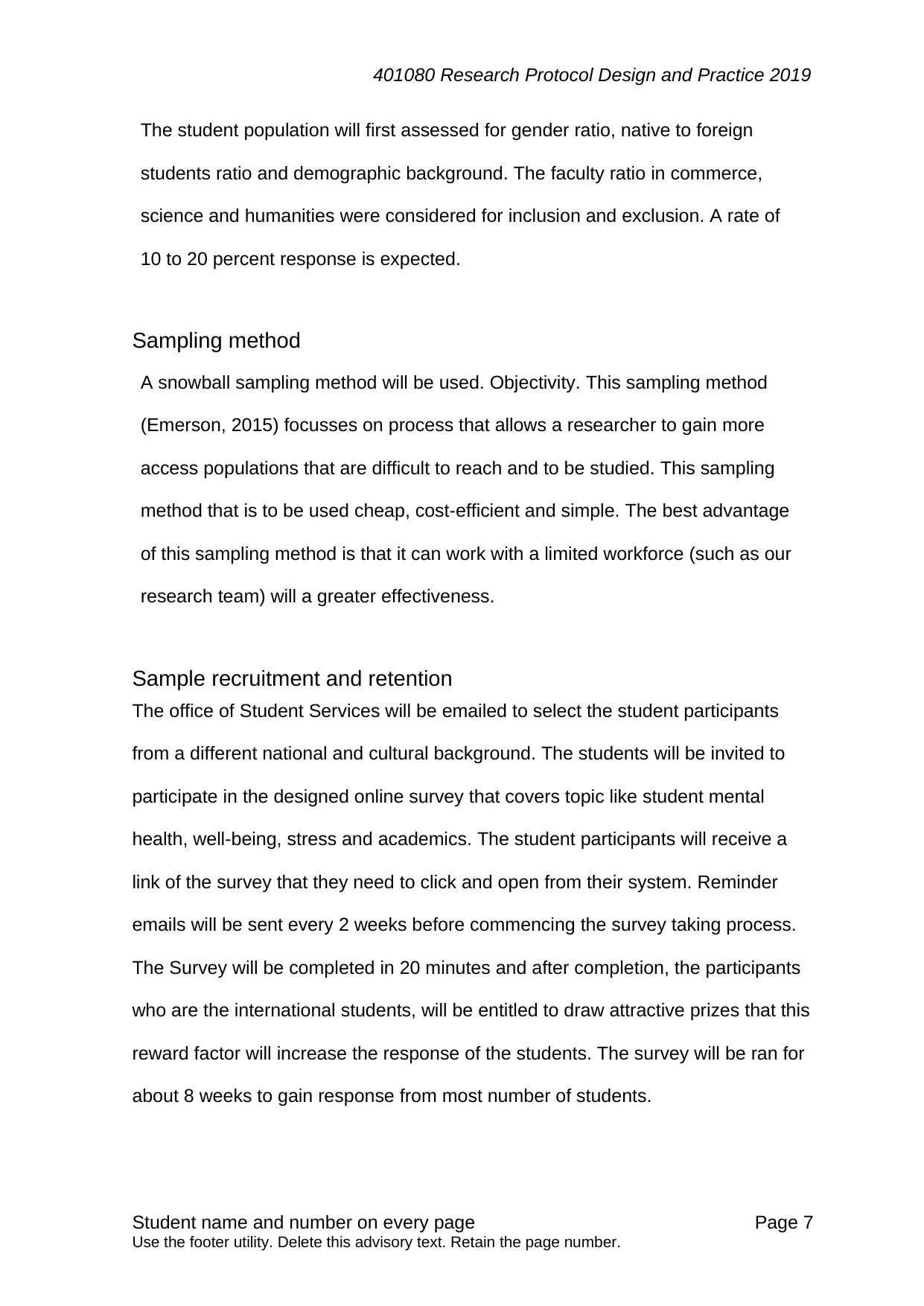
401080 Research Protocol Design and Practice 2019
The student population will first assessed for gender ratio, native to foreign
students ratio and demographic background. The faculty ratio in commerce,
science and humanities were considered for inclusion and exclusion. A rate of
10 to 20 percent response is expected.
Sampling method
A snowball sampling method will be used. Objectivity. This sampling method
(Emerson, 2015) focusses on process that allows a researcher to gain more
access populations that are difficult to reach and to be studied. This sampling
method that is to be used cheap, cost-efficient and simple. The best advantage
of this sampling method is that it can work with a limited workforce (such as our
research team) will a greater effectiveness.
Sample recruitment and retention
The office of Student Services will be emailed to select the student participants
from a different national and cultural background. The students will be invited to
participate in the designed online survey that covers topic like student mental
health, well-being, stress and academics. The student participants will receive a
link of the survey that they need to click and open from their system. Reminder
emails will be sent every 2 weeks before commencing the survey taking process.
The Survey will be completed in 20 minutes and after completion, the participants
who are the international students, will be entitled to draw attractive prizes that this
reward factor will increase the response of the students. The survey will be ran for
about 8 weeks to gain response from most number of students.
Student name and number on every page Page 7
Use the footer utility. Delete this advisory text. Retain the page number.
The student population will first assessed for gender ratio, native to foreign
students ratio and demographic background. The faculty ratio in commerce,
science and humanities were considered for inclusion and exclusion. A rate of
10 to 20 percent response is expected.
Sampling method
A snowball sampling method will be used. Objectivity. This sampling method
(Emerson, 2015) focusses on process that allows a researcher to gain more
access populations that are difficult to reach and to be studied. This sampling
method that is to be used cheap, cost-efficient and simple. The best advantage
of this sampling method is that it can work with a limited workforce (such as our
research team) will a greater effectiveness.
Sample recruitment and retention
The office of Student Services will be emailed to select the student participants
from a different national and cultural background. The students will be invited to
participate in the designed online survey that covers topic like student mental
health, well-being, stress and academics. The student participants will receive a
link of the survey that they need to click and open from their system. Reminder
emails will be sent every 2 weeks before commencing the survey taking process.
The Survey will be completed in 20 minutes and after completion, the participants
who are the international students, will be entitled to draw attractive prizes that this
reward factor will increase the response of the students. The survey will be ran for
about 8 weeks to gain response from most number of students.
Student name and number on every page Page 7
Use the footer utility. Delete this advisory text. Retain the page number.
Paraphrase This Document
Need a fresh take? Get an instant paraphrase of this document with our AI Paraphraser
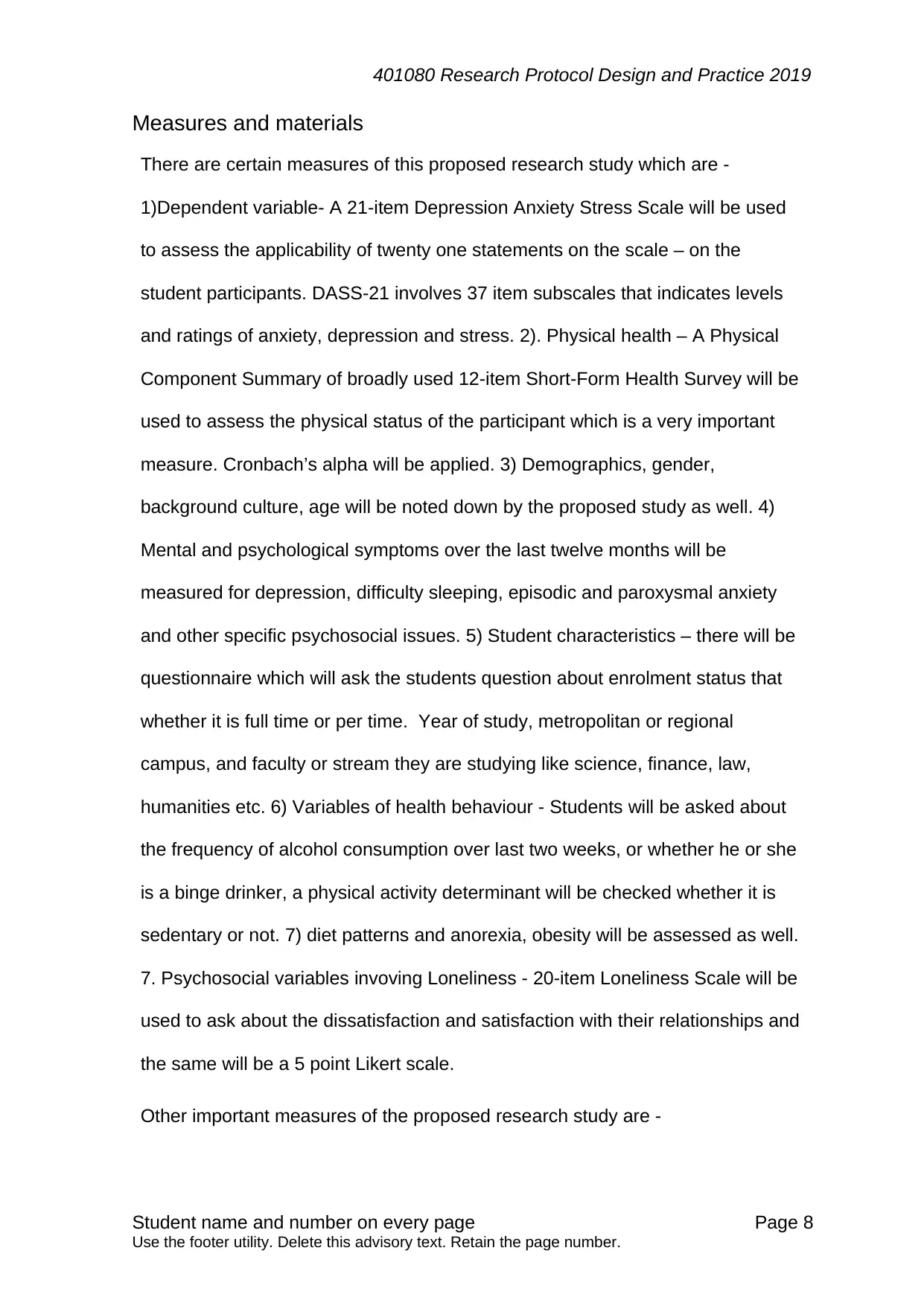
401080 Research Protocol Design and Practice 2019
Measures and materials
There are certain measures of this proposed research study which are -
1)Dependent variable- A 21-item Depression Anxiety Stress Scale will be used
to assess the applicability of twenty one statements on the scale – on the
student participants. DASS-21 involves 37 item subscales that indicates levels
and ratings of anxiety, depression and stress. 2). Physical health – A Physical
Component Summary of broadly used 12-item Short-Form Health Survey will be
used to assess the physical status of the participant which is a very important
measure. Cronbach’s alpha will be applied. 3) Demographics, gender,
background culture, age will be noted down by the proposed study as well. 4)
Mental and psychological symptoms over the last twelve months will be
measured for depression, difficulty sleeping, episodic and paroxysmal anxiety
and other specific psychosocial issues. 5) Student characteristics – there will be
questionnaire which will ask the students question about enrolment status that
whether it is full time or per time. Year of study, metropolitan or regional
campus, and faculty or stream they are studying like science, finance, law,
humanities etc. 6) Variables of health behaviour - Students will be asked about
the frequency of alcohol consumption over last two weeks, or whether he or she
is a binge drinker, a physical activity determinant will be checked whether it is
sedentary or not. 7) diet patterns and anorexia, obesity will be assessed as well.
7. Psychosocial variables invoving Loneliness - 20-item Loneliness Scale will be
used to ask about the dissatisfaction and satisfaction with their relationships and
the same will be a 5 point Likert scale.
Other important measures of the proposed research study are -
Student name and number on every page Page 8
Use the footer utility. Delete this advisory text. Retain the page number.
Measures and materials
There are certain measures of this proposed research study which are -
1)Dependent variable- A 21-item Depression Anxiety Stress Scale will be used
to assess the applicability of twenty one statements on the scale – on the
student participants. DASS-21 involves 37 item subscales that indicates levels
and ratings of anxiety, depression and stress. 2). Physical health – A Physical
Component Summary of broadly used 12-item Short-Form Health Survey will be
used to assess the physical status of the participant which is a very important
measure. Cronbach’s alpha will be applied. 3) Demographics, gender,
background culture, age will be noted down by the proposed study as well. 4)
Mental and psychological symptoms over the last twelve months will be
measured for depression, difficulty sleeping, episodic and paroxysmal anxiety
and other specific psychosocial issues. 5) Student characteristics – there will be
questionnaire which will ask the students question about enrolment status that
whether it is full time or per time. Year of study, metropolitan or regional
campus, and faculty or stream they are studying like science, finance, law,
humanities etc. 6) Variables of health behaviour - Students will be asked about
the frequency of alcohol consumption over last two weeks, or whether he or she
is a binge drinker, a physical activity determinant will be checked whether it is
sedentary or not. 7) diet patterns and anorexia, obesity will be assessed as well.
7. Psychosocial variables invoving Loneliness - 20-item Loneliness Scale will be
used to ask about the dissatisfaction and satisfaction with their relationships and
the same will be a 5 point Likert scale.
Other important measures of the proposed research study are -
Student name and number on every page Page 8
Use the footer utility. Delete this advisory text. Retain the page number.
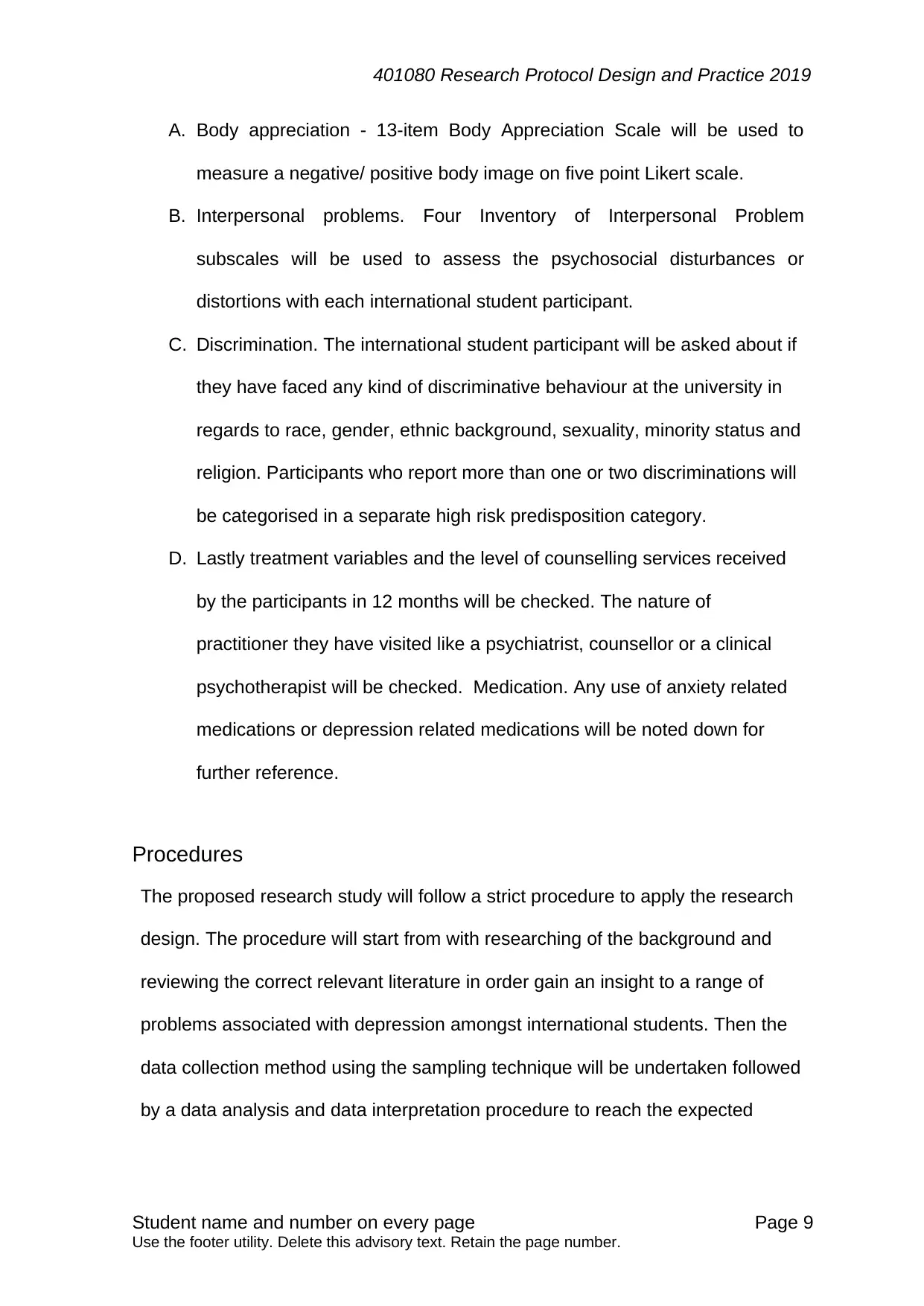
401080 Research Protocol Design and Practice 2019
A. Body appreciation - 13-item Body Appreciation Scale will be used to
measure a negative/ positive body image on five point Likert scale.
B. Interpersonal problems. Four Inventory of Interpersonal Problem
subscales will be used to assess the psychosocial disturbances or
distortions with each international student participant.
C. Discrimination. The international student participant will be asked about if
they have faced any kind of discriminative behaviour at the university in
regards to race, gender, ethnic background, sexuality, minority status and
religion. Participants who report more than one or two discriminations will
be categorised in a separate high risk predisposition category.
D. Lastly treatment variables and the level of counselling services received
by the participants in 12 months will be checked. The nature of
practitioner they have visited like a psychiatrist, counsellor or a clinical
psychotherapist will be checked. Medication. Any use of anxiety related
medications or depression related medications will be noted down for
further reference.
Procedures
The proposed research study will follow a strict procedure to apply the research
design. The procedure will start from with researching of the background and
reviewing the correct relevant literature in order gain an insight to a range of
problems associated with depression amongst international students. Then the
data collection method using the sampling technique will be undertaken followed
by a data analysis and data interpretation procedure to reach the expected
Student name and number on every page Page 9
Use the footer utility. Delete this advisory text. Retain the page number.
A. Body appreciation - 13-item Body Appreciation Scale will be used to
measure a negative/ positive body image on five point Likert scale.
B. Interpersonal problems. Four Inventory of Interpersonal Problem
subscales will be used to assess the psychosocial disturbances or
distortions with each international student participant.
C. Discrimination. The international student participant will be asked about if
they have faced any kind of discriminative behaviour at the university in
regards to race, gender, ethnic background, sexuality, minority status and
religion. Participants who report more than one or two discriminations will
be categorised in a separate high risk predisposition category.
D. Lastly treatment variables and the level of counselling services received
by the participants in 12 months will be checked. The nature of
practitioner they have visited like a psychiatrist, counsellor or a clinical
psychotherapist will be checked. Medication. Any use of anxiety related
medications or depression related medications will be noted down for
further reference.
Procedures
The proposed research study will follow a strict procedure to apply the research
design. The procedure will start from with researching of the background and
reviewing the correct relevant literature in order gain an insight to a range of
problems associated with depression amongst international students. Then the
data collection method using the sampling technique will be undertaken followed
by a data analysis and data interpretation procedure to reach the expected
Student name and number on every page Page 9
Use the footer utility. Delete this advisory text. Retain the page number.
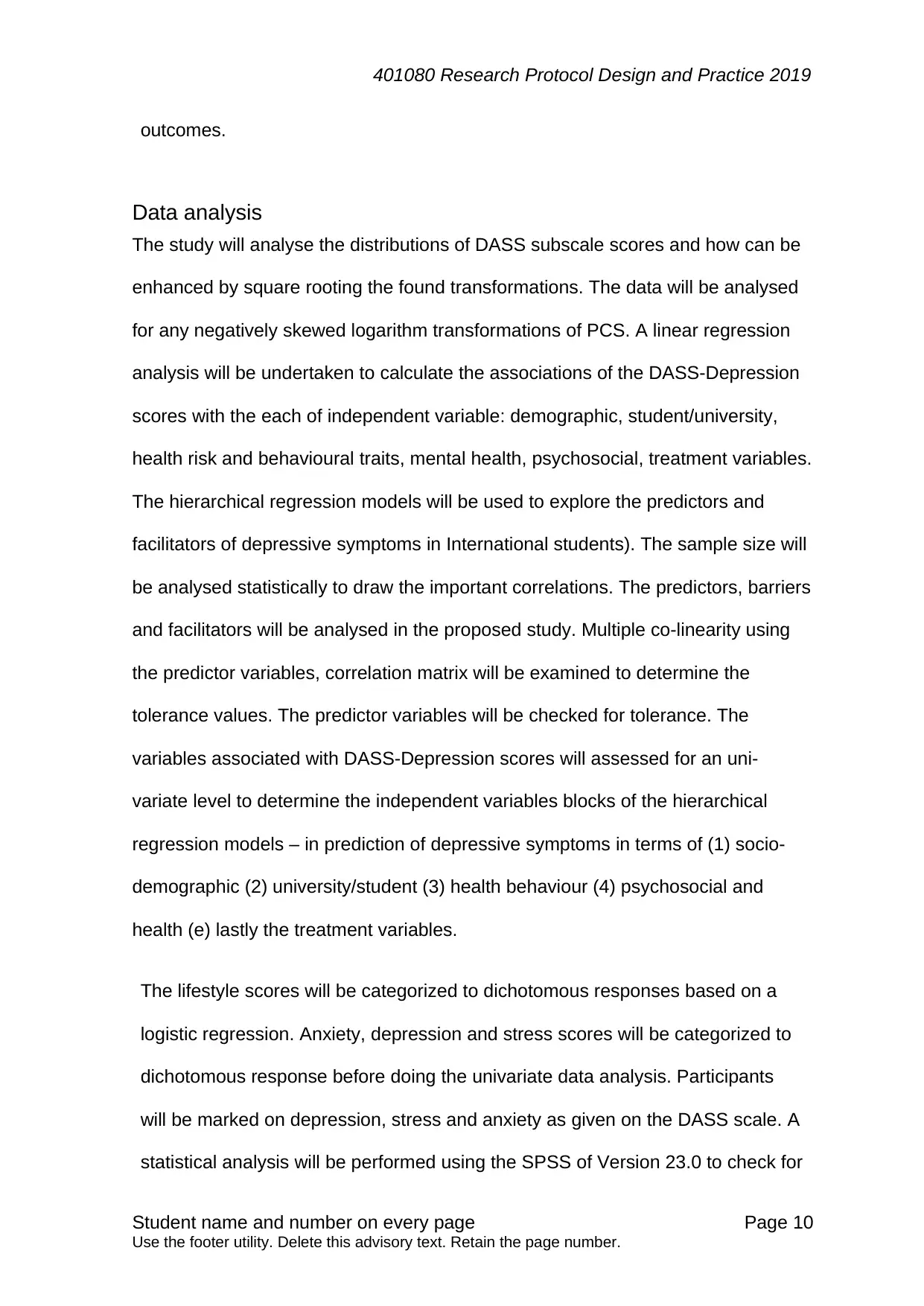
401080 Research Protocol Design and Practice 2019
outcomes.
Data analysis
The study will analyse the distributions of DASS subscale scores and how can be
enhanced by square rooting the found transformations. The data will be analysed
for any negatively skewed logarithm transformations of PCS. A linear regression
analysis will be undertaken to calculate the associations of the DASS-Depression
scores with the each of independent variable: demographic, student/university,
health risk and behavioural traits, mental health, psychosocial, treatment variables.
The hierarchical regression models will be used to explore the predictors and
facilitators of depressive symptoms in International students). The sample size will
be analysed statistically to draw the important correlations. The predictors, barriers
and facilitators will be analysed in the proposed study. Multiple co-linearity using
the predictor variables, correlation matrix will be examined to determine the
tolerance values. The predictor variables will be checked for tolerance. The
variables associated with DASS-Depression scores will assessed for an uni-
variate level to determine the independent variables blocks of the hierarchical
regression models – in prediction of depressive symptoms in terms of (1) socio-
demographic (2) university/student (3) health behaviour (4) psychosocial and
health (e) lastly the treatment variables.
The lifestyle scores will be categorized to dichotomous responses based on a
logistic regression. Anxiety, depression and stress scores will be categorized to
dichotomous response before doing the univariate data analysis. Participants
will be marked on depression, stress and anxiety as given on the DASS scale. A
statistical analysis will be performed using the SPSS of Version 23.0 to check for
Student name and number on every page Page 10
Use the footer utility. Delete this advisory text. Retain the page number.
outcomes.
Data analysis
The study will analyse the distributions of DASS subscale scores and how can be
enhanced by square rooting the found transformations. The data will be analysed
for any negatively skewed logarithm transformations of PCS. A linear regression
analysis will be undertaken to calculate the associations of the DASS-Depression
scores with the each of independent variable: demographic, student/university,
health risk and behavioural traits, mental health, psychosocial, treatment variables.
The hierarchical regression models will be used to explore the predictors and
facilitators of depressive symptoms in International students). The sample size will
be analysed statistically to draw the important correlations. The predictors, barriers
and facilitators will be analysed in the proposed study. Multiple co-linearity using
the predictor variables, correlation matrix will be examined to determine the
tolerance values. The predictor variables will be checked for tolerance. The
variables associated with DASS-Depression scores will assessed for an uni-
variate level to determine the independent variables blocks of the hierarchical
regression models – in prediction of depressive symptoms in terms of (1) socio-
demographic (2) university/student (3) health behaviour (4) psychosocial and
health (e) lastly the treatment variables.
The lifestyle scores will be categorized to dichotomous responses based on a
logistic regression. Anxiety, depression and stress scores will be categorized to
dichotomous response before doing the univariate data analysis. Participants
will be marked on depression, stress and anxiety as given on the DASS scale. A
statistical analysis will be performed using the SPSS of Version 23.0 to check for
Student name and number on every page Page 10
Use the footer utility. Delete this advisory text. Retain the page number.
Secure Best Marks with AI Grader
Need help grading? Try our AI Grader for instant feedback on your assignments.
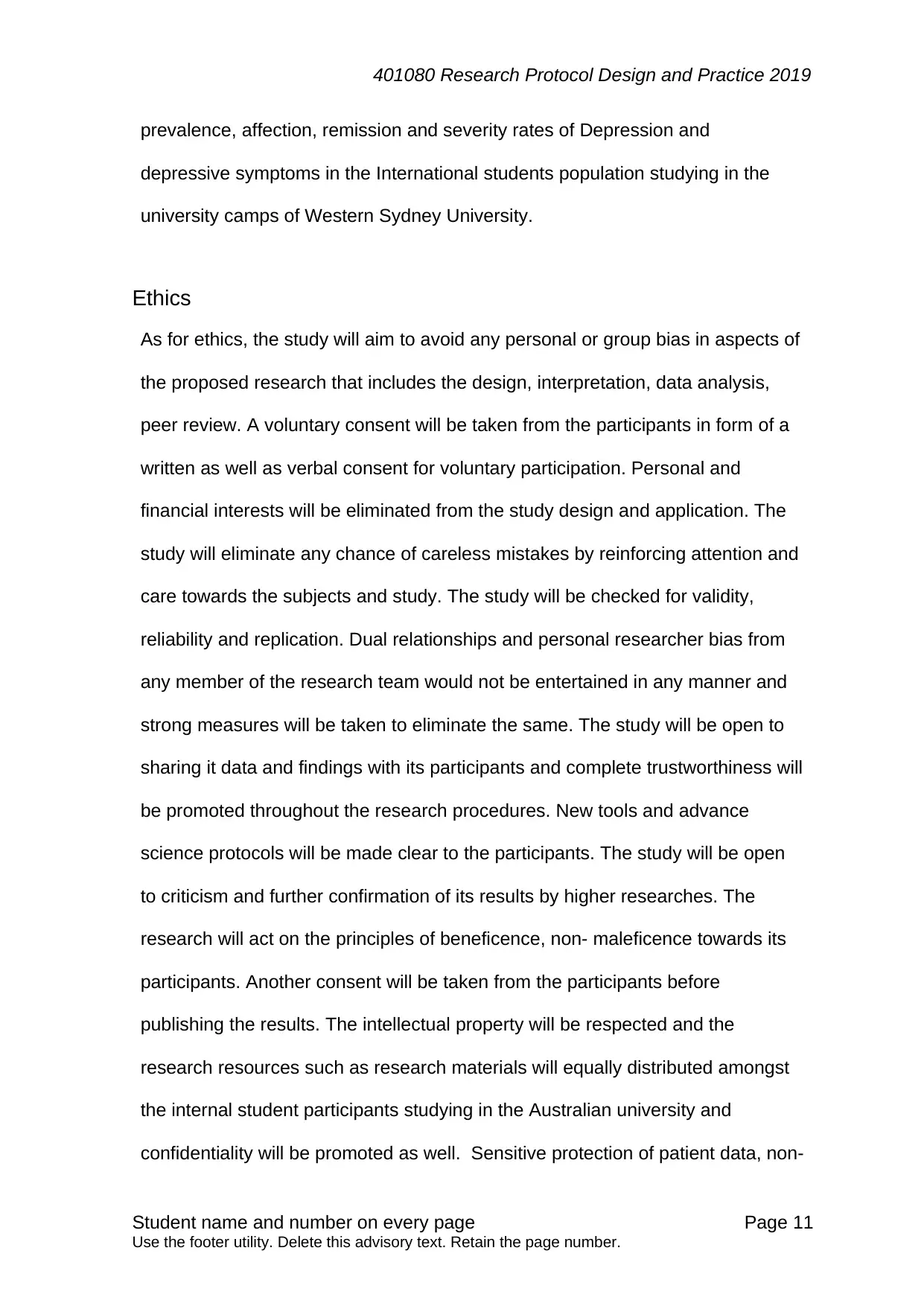
401080 Research Protocol Design and Practice 2019
prevalence, affection, remission and severity rates of Depression and
depressive symptoms in the International students population studying in the
university camps of Western Sydney University.
Ethics
As for ethics, the study will aim to avoid any personal or group bias in aspects of
the proposed research that includes the design, interpretation, data analysis,
peer review. A voluntary consent will be taken from the participants in form of a
written as well as verbal consent for voluntary participation. Personal and
financial interests will be eliminated from the study design and application. The
study will eliminate any chance of careless mistakes by reinforcing attention and
care towards the subjects and study. The study will be checked for validity,
reliability and replication. Dual relationships and personal researcher bias from
any member of the research team would not be entertained in any manner and
strong measures will be taken to eliminate the same. The study will be open to
sharing it data and findings with its participants and complete trustworthiness will
be promoted throughout the research procedures. New tools and advance
science protocols will be made clear to the participants. The study will be open
to criticism and further confirmation of its results by higher researches. The
research will act on the principles of beneficence, non- maleficence towards its
participants. Another consent will be taken from the participants before
publishing the results. The intellectual property will be respected and the
research resources such as research materials will equally distributed amongst
the internal student participants studying in the Australian university and
confidentiality will be promoted as well. Sensitive protection of patient data, non-
Student name and number on every page Page 11
Use the footer utility. Delete this advisory text. Retain the page number.
prevalence, affection, remission and severity rates of Depression and
depressive symptoms in the International students population studying in the
university camps of Western Sydney University.
Ethics
As for ethics, the study will aim to avoid any personal or group bias in aspects of
the proposed research that includes the design, interpretation, data analysis,
peer review. A voluntary consent will be taken from the participants in form of a
written as well as verbal consent for voluntary participation. Personal and
financial interests will be eliminated from the study design and application. The
study will eliminate any chance of careless mistakes by reinforcing attention and
care towards the subjects and study. The study will be checked for validity,
reliability and replication. Dual relationships and personal researcher bias from
any member of the research team would not be entertained in any manner and
strong measures will be taken to eliminate the same. The study will be open to
sharing it data and findings with its participants and complete trustworthiness will
be promoted throughout the research procedures. New tools and advance
science protocols will be made clear to the participants. The study will be open
to criticism and further confirmation of its results by higher researches. The
research will act on the principles of beneficence, non- maleficence towards its
participants. Another consent will be taken from the participants before
publishing the results. The intellectual property will be respected and the
research resources such as research materials will equally distributed amongst
the internal student participants studying in the Australian university and
confidentiality will be promoted as well. Sensitive protection of patient data, non-
Student name and number on every page Page 11
Use the footer utility. Delete this advisory text. Retain the page number.
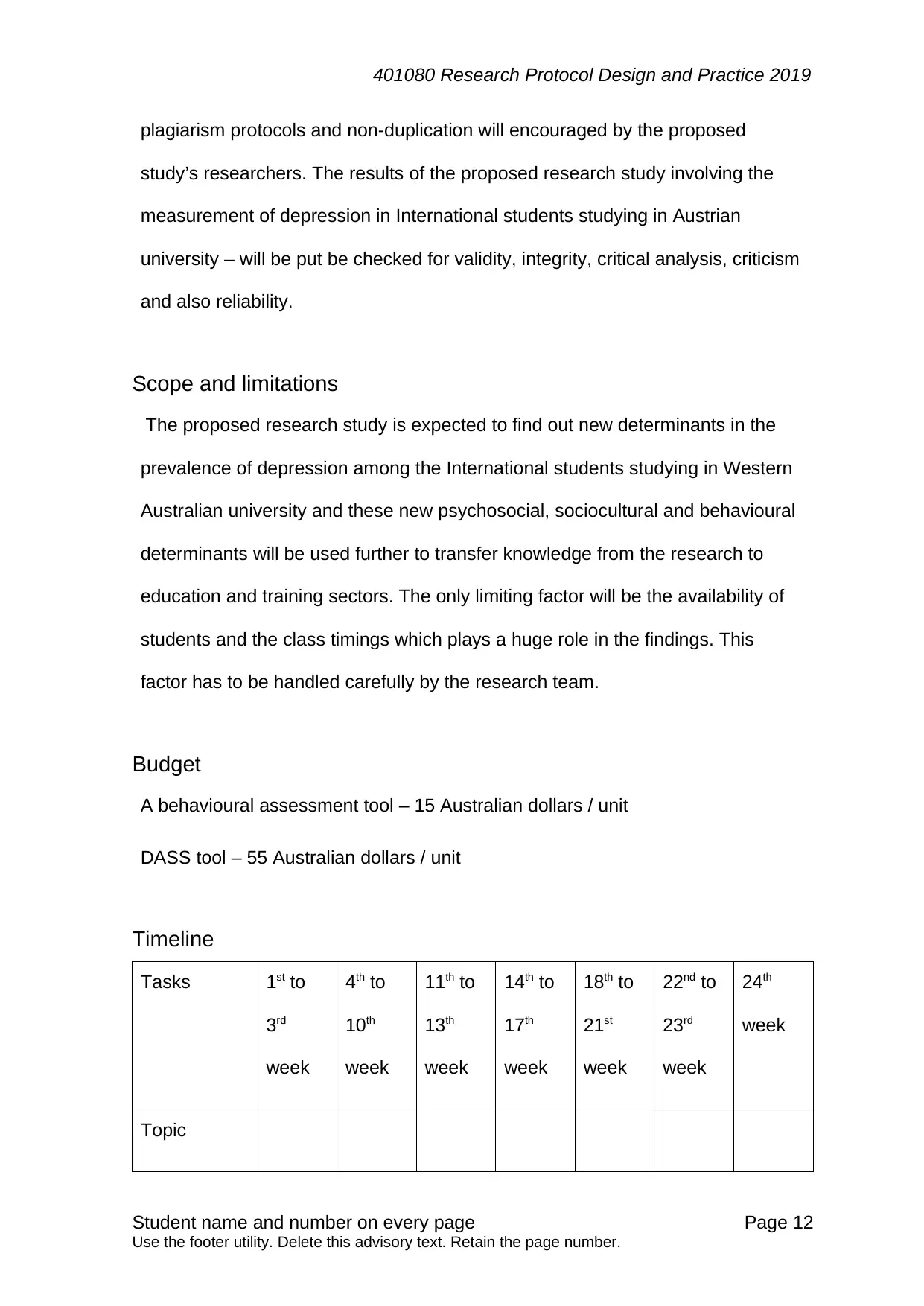
401080 Research Protocol Design and Practice 2019
plagiarism protocols and non-duplication will encouraged by the proposed
study’s researchers. The results of the proposed research study involving the
measurement of depression in International students studying in Austrian
university – will be put be checked for validity, integrity, critical analysis, criticism
and also reliability.
Scope and limitations
The proposed research study is expected to find out new determinants in the
prevalence of depression among the International students studying in Western
Australian university and these new psychosocial, sociocultural and behavioural
determinants will be used further to transfer knowledge from the research to
education and training sectors. The only limiting factor will be the availability of
students and the class timings which plays a huge role in the findings. This
factor has to be handled carefully by the research team.
Budget
A behavioural assessment tool – 15 Australian dollars / unit
DASS tool – 55 Australian dollars / unit
Timeline
Tasks 1st to
3rd
week
4th to
10th
week
11th to
13th
week
14th to
17th
week
18th to
21st
week
22nd to
23rd
week
24th
week
Topic
Student name and number on every page Page 12
Use the footer utility. Delete this advisory text. Retain the page number.
plagiarism protocols and non-duplication will encouraged by the proposed
study’s researchers. The results of the proposed research study involving the
measurement of depression in International students studying in Austrian
university – will be put be checked for validity, integrity, critical analysis, criticism
and also reliability.
Scope and limitations
The proposed research study is expected to find out new determinants in the
prevalence of depression among the International students studying in Western
Australian university and these new psychosocial, sociocultural and behavioural
determinants will be used further to transfer knowledge from the research to
education and training sectors. The only limiting factor will be the availability of
students and the class timings which plays a huge role in the findings. This
factor has to be handled carefully by the research team.
Budget
A behavioural assessment tool – 15 Australian dollars / unit
DASS tool – 55 Australian dollars / unit
Timeline
Tasks 1st to
3rd
week
4th to
10th
week
11th to
13th
week
14th to
17th
week
18th to
21st
week
22nd to
23rd
week
24th
week
Topic
Student name and number on every page Page 12
Use the footer utility. Delete this advisory text. Retain the page number.
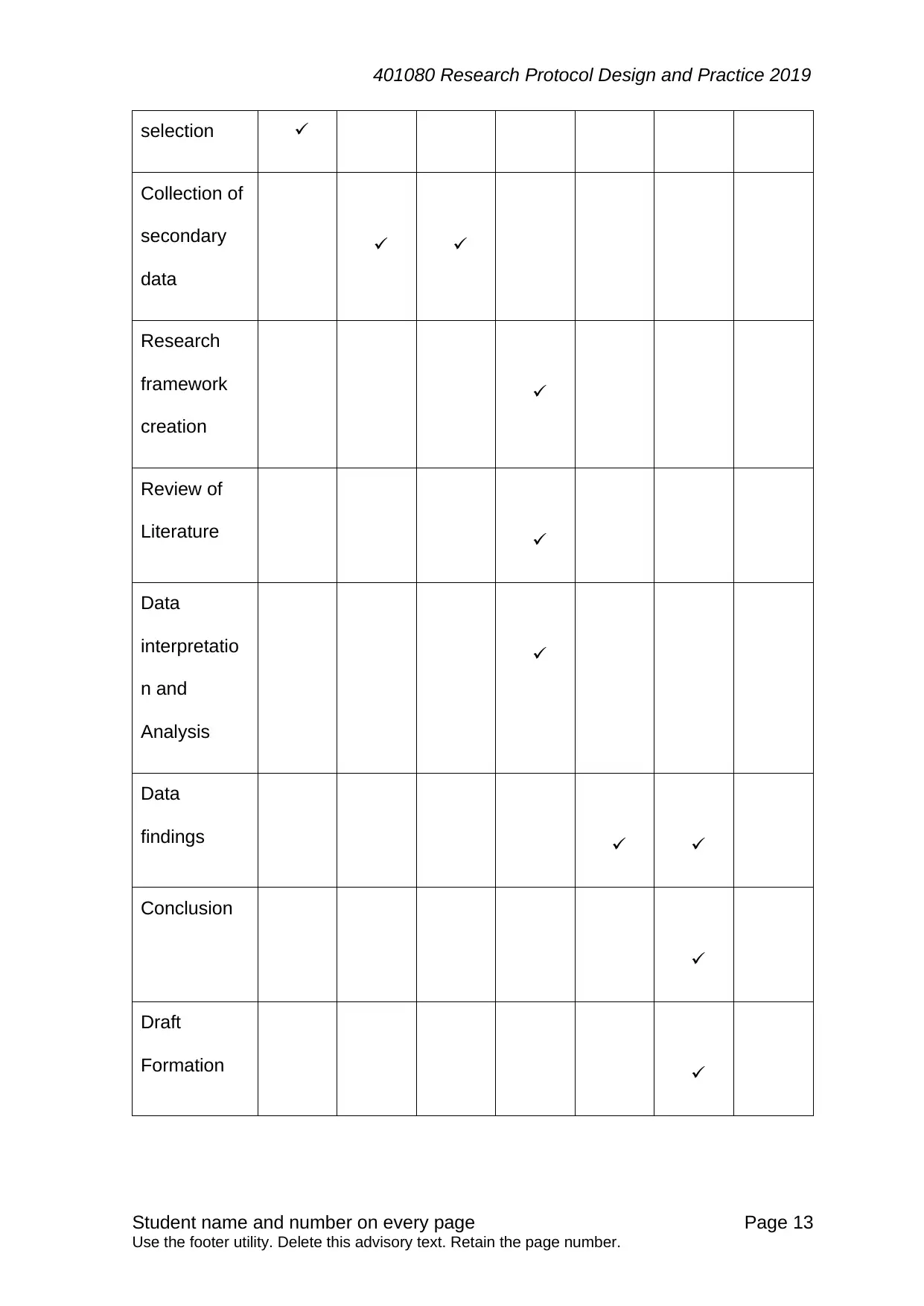
401080 Research Protocol Design and Practice 2019
selection
Collection of
secondary
data
Research
framework
creation
Review of
Literature
Data
interpretatio
n and
Analysis
Data
findings
Conclusion
Draft
Formation
Student name and number on every page Page 13
Use the footer utility. Delete this advisory text. Retain the page number.
selection
Collection of
secondary
data
Research
framework
creation
Review of
Literature
Data
interpretatio
n and
Analysis
Data
findings
Conclusion
Draft
Formation
Student name and number on every page Page 13
Use the footer utility. Delete this advisory text. Retain the page number.
Paraphrase This Document
Need a fresh take? Get an instant paraphrase of this document with our AI Paraphraser
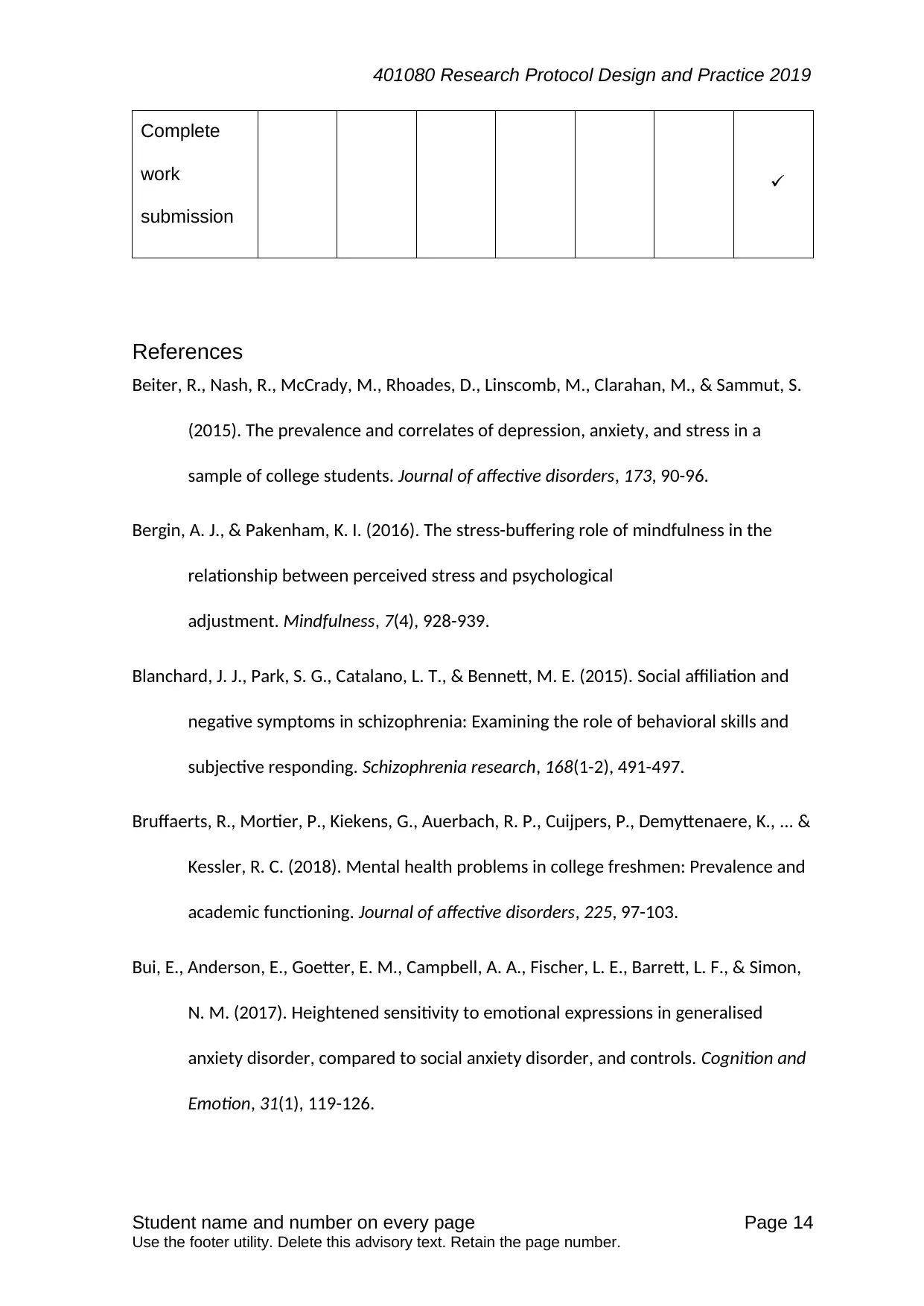
401080 Research Protocol Design and Practice 2019
Complete
work
submission
References
Beiter, R., Nash, R., McCrady, M., Rhoades, D., Linscomb, M., Clarahan, M., & Sammut, S.
(2015). The prevalence and correlates of depression, anxiety, and stress in a
sample of college students. Journal of affective disorders, 173, 90-96.
Bergin, A. J., & Pakenham, K. I. (2016). The stress-buffering role of mindfulness in the
relationship between perceived stress and psychological
adjustment. Mindfulness, 7(4), 928-939.
Blanchard, J. J., Park, S. G., Catalano, L. T., & Bennett, M. E. (2015). Social affiliation and
negative symptoms in schizophrenia: Examining the role of behavioral skills and
subjective responding. Schizophrenia research, 168(1-2), 491-497.
Bruffaerts, R., Mortier, P., Kiekens, G., Auerbach, R. P., Cuijpers, P., Demyttenaere, K., ... &
Kessler, R. C. (2018). Mental health problems in college freshmen: Prevalence and
academic functioning. Journal of affective disorders, 225, 97-103.
Bui, E., Anderson, E., Goetter, E. M., Campbell, A. A., Fischer, L. E., Barrett, L. F., & Simon,
N. M. (2017). Heightened sensitivity to emotional expressions in generalised
anxiety disorder, compared to social anxiety disorder, and controls. Cognition and
Emotion, 31(1), 119-126.
Student name and number on every page Page 14
Use the footer utility. Delete this advisory text. Retain the page number.
Complete
work
submission
References
Beiter, R., Nash, R., McCrady, M., Rhoades, D., Linscomb, M., Clarahan, M., & Sammut, S.
(2015). The prevalence and correlates of depression, anxiety, and stress in a
sample of college students. Journal of affective disorders, 173, 90-96.
Bergin, A. J., & Pakenham, K. I. (2016). The stress-buffering role of mindfulness in the
relationship between perceived stress and psychological
adjustment. Mindfulness, 7(4), 928-939.
Blanchard, J. J., Park, S. G., Catalano, L. T., & Bennett, M. E. (2015). Social affiliation and
negative symptoms in schizophrenia: Examining the role of behavioral skills and
subjective responding. Schizophrenia research, 168(1-2), 491-497.
Bruffaerts, R., Mortier, P., Kiekens, G., Auerbach, R. P., Cuijpers, P., Demyttenaere, K., ... &
Kessler, R. C. (2018). Mental health problems in college freshmen: Prevalence and
academic functioning. Journal of affective disorders, 225, 97-103.
Bui, E., Anderson, E., Goetter, E. M., Campbell, A. A., Fischer, L. E., Barrett, L. F., & Simon,
N. M. (2017). Heightened sensitivity to emotional expressions in generalised
anxiety disorder, compared to social anxiety disorder, and controls. Cognition and
Emotion, 31(1), 119-126.
Student name and number on every page Page 14
Use the footer utility. Delete this advisory text. Retain the page number.
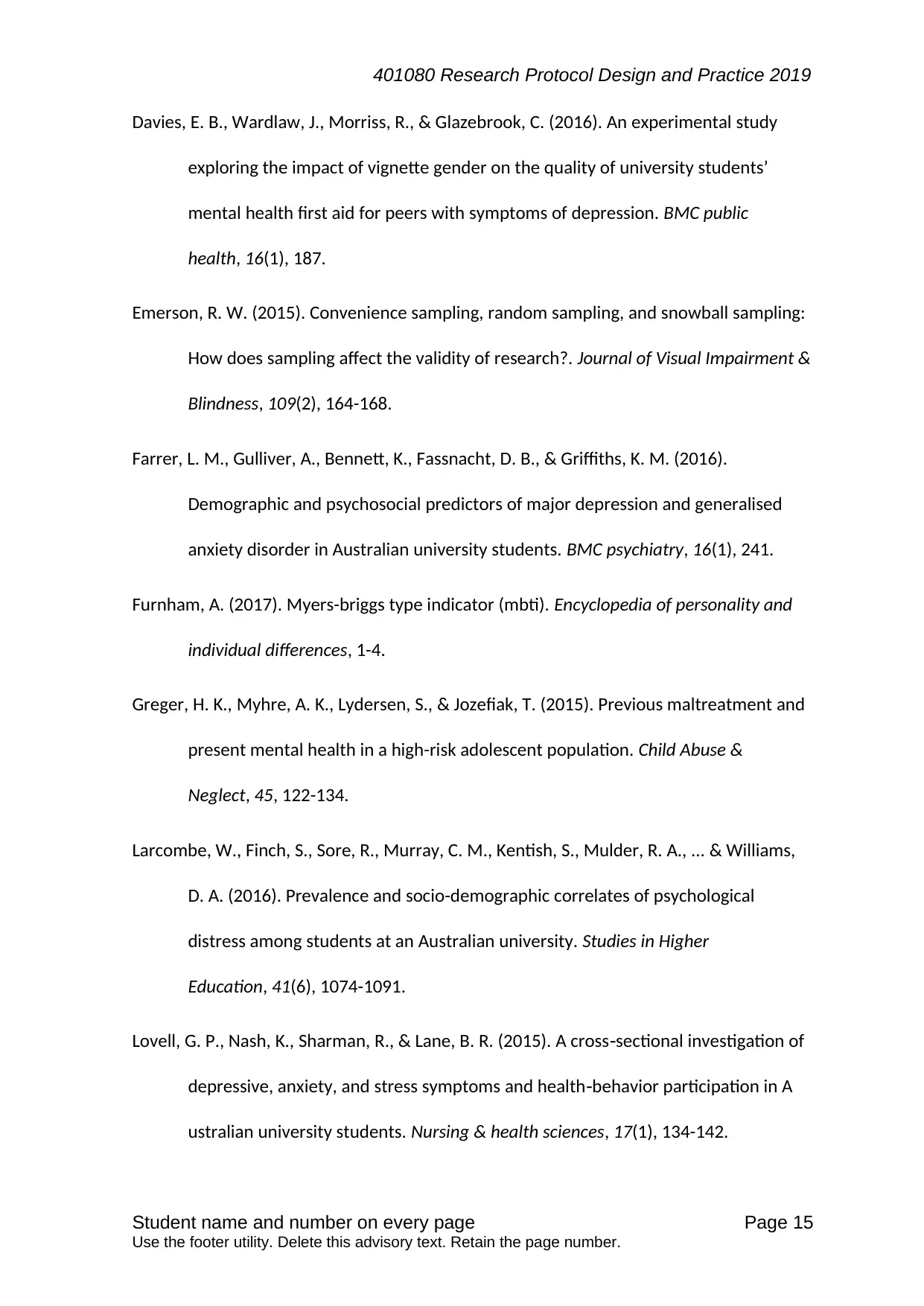
401080 Research Protocol Design and Practice 2019
Davies, E. B., Wardlaw, J., Morriss, R., & Glazebrook, C. (2016). An experimental study
exploring the impact of vignette gender on the quality of university students’
mental health first aid for peers with symptoms of depression. BMC public
health, 16(1), 187.
Emerson, R. W. (2015). Convenience sampling, random sampling, and snowball sampling:
How does sampling affect the validity of research?. Journal of Visual Impairment &
Blindness, 109(2), 164-168.
Farrer, L. M., Gulliver, A., Bennett, K., Fassnacht, D. B., & Griffiths, K. M. (2016).
Demographic and psychosocial predictors of major depression and generalised
anxiety disorder in Australian university students. BMC psychiatry, 16(1), 241.
Furnham, A. (2017). Myers-briggs type indicator (mbti). Encyclopedia of personality and
individual differences, 1-4.
Greger, H. K., Myhre, A. K., Lydersen, S., & Jozefiak, T. (2015). Previous maltreatment and
present mental health in a high-risk adolescent population. Child Abuse &
Neglect, 45, 122-134.
Larcombe, W., Finch, S., Sore, R., Murray, C. M., Kentish, S., Mulder, R. A., ... & Williams,
D. A. (2016). Prevalence and socio-demographic correlates of psychological
distress among students at an Australian university. Studies in Higher
Education, 41(6), 1074-1091.
Lovell, G. P., Nash, K., Sharman, R., & Lane, B. R. (2015). A cross sectional investigation of‐
depressive, anxiety, and stress symptoms and health behavior participation in A‐
ustralian university students. Nursing & health sciences, 17(1), 134-142.
Student name and number on every page Page 15
Use the footer utility. Delete this advisory text. Retain the page number.
Davies, E. B., Wardlaw, J., Morriss, R., & Glazebrook, C. (2016). An experimental study
exploring the impact of vignette gender on the quality of university students’
mental health first aid for peers with symptoms of depression. BMC public
health, 16(1), 187.
Emerson, R. W. (2015). Convenience sampling, random sampling, and snowball sampling:
How does sampling affect the validity of research?. Journal of Visual Impairment &
Blindness, 109(2), 164-168.
Farrer, L. M., Gulliver, A., Bennett, K., Fassnacht, D. B., & Griffiths, K. M. (2016).
Demographic and psychosocial predictors of major depression and generalised
anxiety disorder in Australian university students. BMC psychiatry, 16(1), 241.
Furnham, A. (2017). Myers-briggs type indicator (mbti). Encyclopedia of personality and
individual differences, 1-4.
Greger, H. K., Myhre, A. K., Lydersen, S., & Jozefiak, T. (2015). Previous maltreatment and
present mental health in a high-risk adolescent population. Child Abuse &
Neglect, 45, 122-134.
Larcombe, W., Finch, S., Sore, R., Murray, C. M., Kentish, S., Mulder, R. A., ... & Williams,
D. A. (2016). Prevalence and socio-demographic correlates of psychological
distress among students at an Australian university. Studies in Higher
Education, 41(6), 1074-1091.
Lovell, G. P., Nash, K., Sharman, R., & Lane, B. R. (2015). A cross sectional investigation of‐
depressive, anxiety, and stress symptoms and health behavior participation in A‐
ustralian university students. Nursing & health sciences, 17(1), 134-142.
Student name and number on every page Page 15
Use the footer utility. Delete this advisory text. Retain the page number.
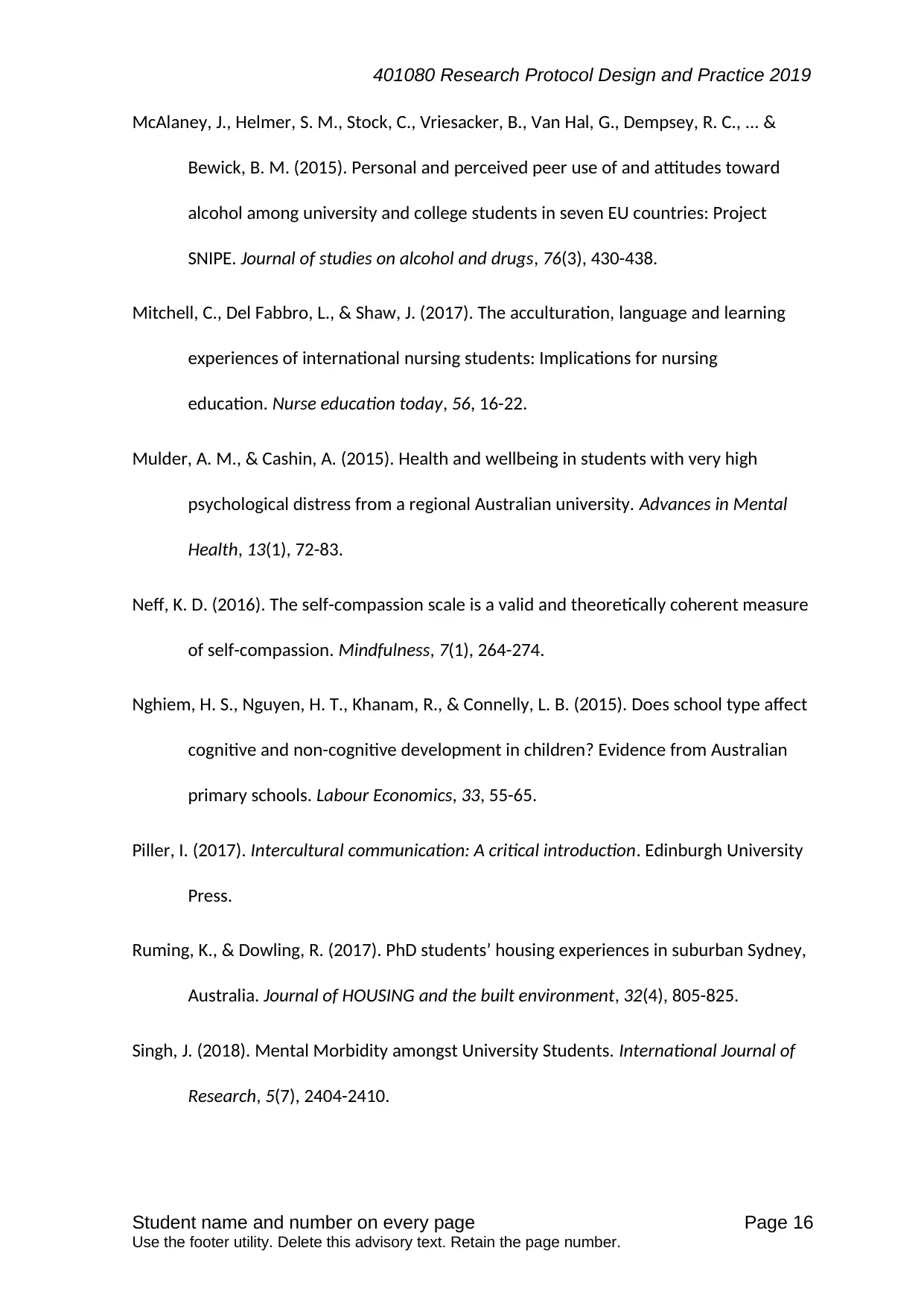
401080 Research Protocol Design and Practice 2019
McAlaney, J., Helmer, S. M., Stock, C., Vriesacker, B., Van Hal, G., Dempsey, R. C., ... &
Bewick, B. M. (2015). Personal and perceived peer use of and attitudes toward
alcohol among university and college students in seven EU countries: Project
SNIPE. Journal of studies on alcohol and drugs, 76(3), 430-438.
Mitchell, C., Del Fabbro, L., & Shaw, J. (2017). The acculturation, language and learning
experiences of international nursing students: Implications for nursing
education. Nurse education today, 56, 16-22.
Mulder, A. M., & Cashin, A. (2015). Health and wellbeing in students with very high
psychological distress from a regional Australian university. Advances in Mental
Health, 13(1), 72-83.
Neff, K. D. (2016). The self-compassion scale is a valid and theoretically coherent measure
of self-compassion. Mindfulness, 7(1), 264-274.
Nghiem, H. S., Nguyen, H. T., Khanam, R., & Connelly, L. B. (2015). Does school type affect
cognitive and non-cognitive development in children? Evidence from Australian
primary schools. Labour Economics, 33, 55-65.
Piller, I. (2017). Intercultural communication: A critical introduction. Edinburgh University
Press.
Ruming, K., & Dowling, R. (2017). PhD students’ housing experiences in suburban Sydney,
Australia. Journal of HOUSING and the built environment, 32(4), 805-825.
Singh, J. (2018). Mental Morbidity amongst University Students. International Journal of
Research, 5(7), 2404-2410.
Student name and number on every page Page 16
Use the footer utility. Delete this advisory text. Retain the page number.
McAlaney, J., Helmer, S. M., Stock, C., Vriesacker, B., Van Hal, G., Dempsey, R. C., ... &
Bewick, B. M. (2015). Personal and perceived peer use of and attitudes toward
alcohol among university and college students in seven EU countries: Project
SNIPE. Journal of studies on alcohol and drugs, 76(3), 430-438.
Mitchell, C., Del Fabbro, L., & Shaw, J. (2017). The acculturation, language and learning
experiences of international nursing students: Implications for nursing
education. Nurse education today, 56, 16-22.
Mulder, A. M., & Cashin, A. (2015). Health and wellbeing in students with very high
psychological distress from a regional Australian university. Advances in Mental
Health, 13(1), 72-83.
Neff, K. D. (2016). The self-compassion scale is a valid and theoretically coherent measure
of self-compassion. Mindfulness, 7(1), 264-274.
Nghiem, H. S., Nguyen, H. T., Khanam, R., & Connelly, L. B. (2015). Does school type affect
cognitive and non-cognitive development in children? Evidence from Australian
primary schools. Labour Economics, 33, 55-65.
Piller, I. (2017). Intercultural communication: A critical introduction. Edinburgh University
Press.
Ruming, K., & Dowling, R. (2017). PhD students’ housing experiences in suburban Sydney,
Australia. Journal of HOUSING and the built environment, 32(4), 805-825.
Singh, J. (2018). Mental Morbidity amongst University Students. International Journal of
Research, 5(7), 2404-2410.
Student name and number on every page Page 16
Use the footer utility. Delete this advisory text. Retain the page number.
Secure Best Marks with AI Grader
Need help grading? Try our AI Grader for instant feedback on your assignments.
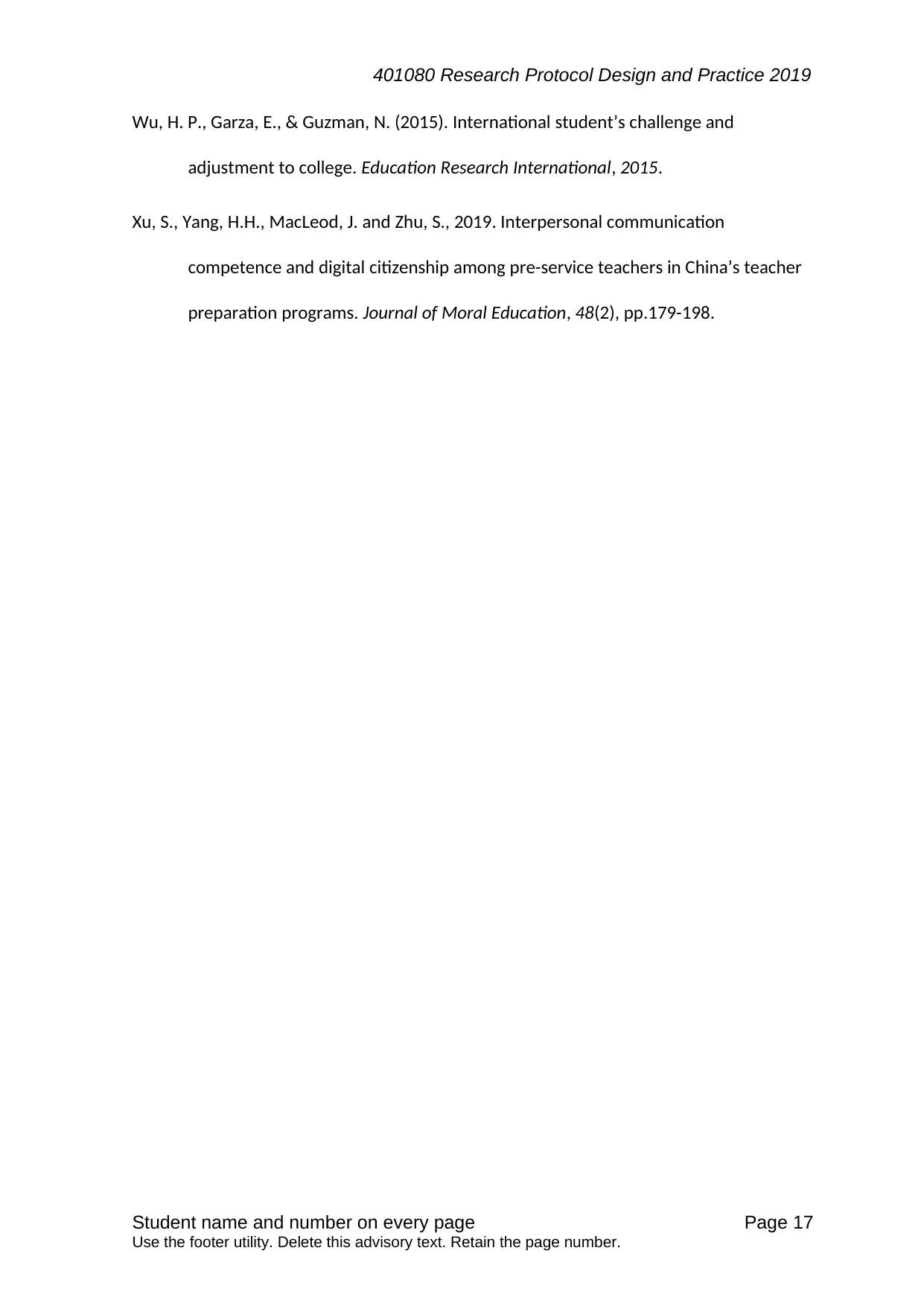
401080 Research Protocol Design and Practice 2019
Wu, H. P., Garza, E., & Guzman, N. (2015). International student’s challenge and
adjustment to college. Education Research International, 2015.
Xu, S., Yang, H.H., MacLeod, J. and Zhu, S., 2019. Interpersonal communication
competence and digital citizenship among pre-service teachers in China’s teacher
preparation programs. Journal of Moral Education, 48(2), pp.179-198.
Student name and number on every page Page 17
Use the footer utility. Delete this advisory text. Retain the page number.
Wu, H. P., Garza, E., & Guzman, N. (2015). International student’s challenge and
adjustment to college. Education Research International, 2015.
Xu, S., Yang, H.H., MacLeod, J. and Zhu, S., 2019. Interpersonal communication
competence and digital citizenship among pre-service teachers in China’s teacher
preparation programs. Journal of Moral Education, 48(2), pp.179-198.
Student name and number on every page Page 17
Use the footer utility. Delete this advisory text. Retain the page number.
1 out of 17
Related Documents
Your All-in-One AI-Powered Toolkit for Academic Success.
+13062052269
info@desklib.com
Available 24*7 on WhatsApp / Email
![[object Object]](/_next/static/media/star-bottom.7253800d.svg)
Unlock your academic potential
© 2024 | Zucol Services PVT LTD | All rights reserved.




